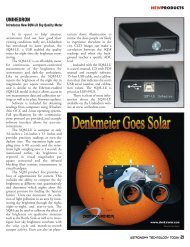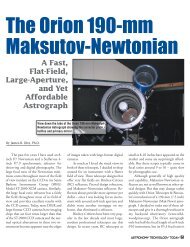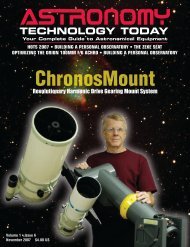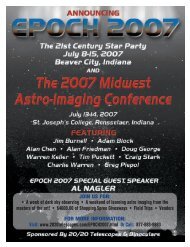magnilux - Astronomy Technology Today
magnilux - Astronomy Technology Today
magnilux - Astronomy Technology Today
You also want an ePaper? Increase the reach of your titles
YUMPU automatically turns print PDFs into web optimized ePapers that Google loves.
THE WILLIAM OPTICS MEGREZ 120-MM REFRACTOR<br />
Image 1 - The Double Cluster in Perseus, NGC 869 and NGC884<br />
Sierra Stars Observatory Network<br />
Now YOU Can Have Access to a World Class<br />
Automated Robotic Observatory System<br />
SPECIAL TRIAL RATE FOR FIRST-TIME USERS!<br />
For a limited time we are promoting a special one-time<br />
rate for new customers using the Sierra Stars<br />
Observatory for the first time. For $50 you get 50<br />
minutes (83 credits) of imaging time. That's more than<br />
a 40 percent discount below our base price.<br />
www.sierrastars.com<br />
New MX-1 Telescope Adapter for iPhone!<br />
The MX-1 is an afocal adapter that attaches an iPhone directly to a<br />
telescope eyepiece for viewing and photography. It is rugged, lightweight<br />
and compatible with any model iPhone. It includes 3 felt-lined attachment<br />
clamps which will adapt to almost any standard 1.25" format eyepiece.<br />
It also can be configured to attach an iPhone to a standard photography<br />
tripod! Amateur astronomers will find the MX-1 a huge hit at star-parties<br />
allowing an iPhone to be used as an ultra-portable display for showing off<br />
your scope's view. The easy dock/undock of the cradle will even let others<br />
use their iPhones for a quick snapshot through your scope. And best of<br />
all, it’s offered at an introductory price of $44.95!<br />
www.<strong>magnilux</strong>.com<br />
APO provided higher magnification for solar<br />
viewing and worked quite well for digital imaging<br />
(see image gallery at www.wildwoodpines.org).<br />
A higher f-number results in less<br />
spherical aberration (another problem with refractors)<br />
than lower f-number refractors. For<br />
imaging with large-format digital cameras, I<br />
use a 0.8x focal reducer/field flattener.<br />
<strong>Today</strong>, many telescope manufacturers<br />
produce doublet refractors that use low-dispersion<br />
glass and special coatings that allow<br />
them to perform very close to an apochromat.<br />
Some call these telescopes semi-APOs or even<br />
APOs, but in my opinion the latter is stretching<br />
it a bit too far.<br />
Last fall, I had the opportunity to test<br />
drive a new refractor, the Megrez 120, made<br />
by William Optics. The Megrez 120 uses a<br />
120-mm (4.7 inches) f/7.5 air-spaced doublet<br />
made with FPL53 ED glass with STM<br />
coatings. FPL stands for femto-photoluminescent,<br />
and FPL53 is a specific type of this<br />
glass that contains no lead or fluorite. The ED<br />
in the specification means extra-low dispersion.<br />
FPL53 glass has about the lowest index<br />
of refraction of any glass made. Finally, STM<br />
means super transmission. The STM coatings<br />
eliminate internal reflections between the elements<br />
in the objective.<br />
The Megrez 120 is the largest in this<br />
William Optics’ line, which includes apertures<br />
of 110 mm, 90 mm, 88 mm, and 72 mm.<br />
The Megrez 120 has a beautifully painted<br />
white tube with gold-colored trim. It comes<br />
with a 2-speed manual focuser with a Digital<br />
Display Gauge (DDG) and a nice set of aluminum<br />
tube rings. The focuser can be rotated<br />
360 degrees to allow a diagonal to be optimally<br />
positioned for any viewing angle. The<br />
scope also comes with an adapter to use 1.25-<br />
inch eyepieces, but it does not come with a<br />
diagonal, a must for visual observing. I recommend<br />
purchasing a high-quality 2-inch diagonal<br />
with this telescope.<br />
The first night I used this scope, I only<br />
performed visual observations. The first thing<br />
I noticed when I unpacked the scope was how<br />
much lighter it was than my smaller 4-inch<br />
APO. I attached it to my German equatorial<br />
mount and then attached a 9x50 finderscope<br />
36 <strong>Astronomy</strong> TECHNOLOGY TODAY

















